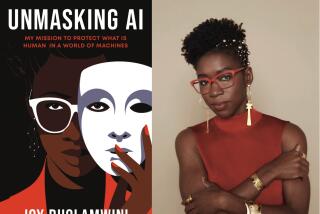‘CAT’ Speaks in Many Tongues : Device Brings a New Kind of Language to Stenography
- Share via
During a recent trip to Holland, Bert Mawhinney delivered a speech in English to a bilingual audience. While he spoke, his wife, a stenotypist, recorded the speech on her court reporter’s machine.
Almost magically, a written version of Anne Mawhinney’s stenotypy version appeared simultaneously on an overhead screen. And instead of appearing in English, her record of the speech showed up in rudimentary Dutch.
Although neither of the Mawhinneys speaks Dutch, the computer-aided transcription (CAT) device attached to Ann Mawhinney’s stenotypy machine used an English-to-Dutch “dictionary” that makes basic translations on an almost-simultaneous basis.
Bugs in System
There are bugs in the system. The translation from English to a second language often produces awkward phrasings. But the demonstration showed how quickly the CAT machine turns spoken words into a written record.
Mawhinney, a former General Dynamics engineer, hooked a computer into his wife’s stenotypy machine after watching Anne, a stenotypist, spend hours typing her notes. That was seven years ago, and the project that he nurtured during his spare time has grown into Xscribe Corp., a La Jolla-based company with $20 million in revenues expected this year.
That growth has come from court and free-lance reporters who turned in their old-fashioned stenotypy machines for a computer-aided version. Last year, 14,000 of the nation’s 25,000 to 35,000 court and free-lance reporters used CAT devices. In 1983, only 6,000 of the machines were in use, according to the National Shorthand Reporters Assn.
Reporters are attracted to the machines because they can boost productivity 30% to 50% and cut back on the number of errors. That news is welcomed by lawyers and judges in busy courtrooms who often blame legal delays on swamped court reporters who must type up countless pages of testimony.
“I think if you told stenotypists that they could no longer use (CAT) devices, many of them would simply drop out of the business,” said Jere L. With, president of Fivecoat and With, a San Diego reporting firm. “It makes that much of a difference.”
“My personal feeling is that stenotypists who haven’t (yet) opted to go the CAT route will do so in a short period of time,” said Jill Berman Wilson, director of research and technology at the National Shorthand Reporters Assn. “The average price has come down significantly in the past five years.”
Although reporters still use the basic stenotypy machine to record spoken words, the CAT devices use a computer that automatically translates stenotypy “markings” into English. Operators can tailor the computer’s “dictionary” to meet their own needs.
The computer is then linked to a printer--either on-site or at one of Xscribe’s service centers around the county--which eliminates the need for a typist. The system is a far cry from the days when reporters used pen and paper to keep records, Mawhinney said. The last “pen writer” in San Diego retired seven years ago, he said, as the CAT revolution began.
The market is dominated by three firms: Xscribe, San Leandro-based Baron Data Systems, and Stenograph Corp., a subsidiary of Quixote Corp. of Skokie, Ill. Interestingly, Stenograph, which produces 95% of the internal components of stenotypy machines used in the United States, sells those components to both Xscribe and Baron Data. The two firms subsequently add their own CAT devices to the Stenograph machines.
Growth Limited
Growth, however, is limited because the stenotypist market will be saturated in just a few years, Mawhinney acknowledged. “We sell a system for as low as $6,000,” Mawhinney said, “but even at that price, it’s a limited market.”
Consequently, Xscribe is chasing the nation’s 700,000 lawyers, many of whom are looking for “litigation support systems” that quickly and accurately transform cumbersome paper documents into records that a computer can handle.
“The large cases are already using mainframe systems that are complicated and expensive to operate,” Mawhinney said. “We will extend the use of systems down to smaller and smaller cases with something that will sit on a desk.”
Xscribe will unveil a litigation support system for smaller law firms next month at the National Shorthand Reporters Assn. meeting in Kansas City, Mo. “It won’t be ready for delivery but it will be good enough for demonstrations,” Mawhinney said.
The company will have a complete system ready for a legal industry trade show in New York in January, where there will likely be competing systems. “We figure Baron Data will be aiming at this market, as will some other companies,” Mawhinney said.
Although Xscribe has done well in the stenotypy business, it will be bumping up against relative giants, including Informatics General, a Los Angeles software and computer applications company with $200 million in sales last year.
Although Informatics has concentrated on serving large law offices, it is “watching developments” at Xscribe’s end of the business.
That kind of competition will likely push Xscribe into making a public offering, something it has held back on during the ongoing computer industry slump.
“I expect we’re going to go public, although we don’t have plans to do so now,” said Mawhinney. “There’s definitely going to be a cash need, although it’s a little way off now.”
Mawhinney still holds 25% of Xscribe’s stock, and, along with a group of “insiders,” still controls 75% of the privately held company’s stock.
So far, Xscribe has funded development through a combination of internally generated funds, a $2.2-million research and development partnership with E.F. Hutton & Associates, and $4 million in equity from two groups of investors.
Although Xscribe considered a public offering during the past year, Mawhinney said, “We knew we wouldn’t get what we wanted. The computer industry has been down a while and we don’t know when it will come around.”
He believes computer-aided transcription has applications beyond the legal system. “It’s really the fastest input from human speech to the computer today,” he maintained. “It’s the fastest way of getting real-time speech into a computer.”
The National Captioning Institute uses that input speed to translate dialogue from live television broadcasts. Stenotypists at the Vienna, Va., not-for-profit company use CAT equipment to record dialogue which, seconds later, appears in print on the home TV sets that are wired to receive closed-captioned television signals.
More to Read
Sign up for Essential California
The most important California stories and recommendations in your inbox every morning.
You may occasionally receive promotional content from the Los Angeles Times.













